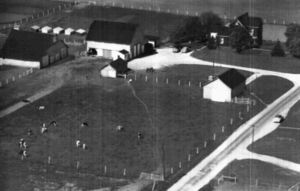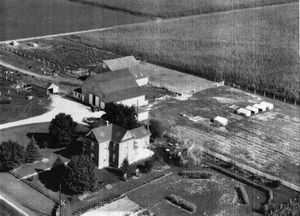Pattengale House
Early Landowners
The original purchaser of the property is unknown, however it is known that early on, Major G. W. Steele owned the land, and after Steele the land was purchased by the Ward family, and then the Harris family (Whitson 1384). The first ownership on public record occurred around 1860, when the property was owned by Mary E. Pope (1860 Platt Map). For an unknown reason, Pope was not included in the 1860 federal census. It is known that she married to James Pope, who was born October 19, 1836 and died Thursday, December 18, 1919, and lived in both Jonesboro and Washington Township with her family of six daughters and two sons. Pope was an active member of the Women’s Relief Corps, the GAR, and the Jonesboro Methodist Church. Pope died in the summer of 1929 at the age of 83, and was survived only by her son, James Pope Jr. (Mary E. Pope... 17)
By 1877, the property had been split into five sections and sold. The property on which 3331 W. 600 S. is now located consisted of forty acres and was purchased by a farmer named Franklin Weaver (1877 Platt Map). Franklin Weaver was married to Elizabeth Weaver, with whom he had ten children, one of which, a boy named Francis, died before he turned ten (1870 Federal Census 44, 1880 Federal Census 40). Because they were African- American, neither Franklin nor Elizabeth’s deaths were recorded in the Marion newspapers.
Bowman Farm
The property was next owned by an Indiana native named John A. Bowman (1903 Platt Map). John Bowman, and his wife, Flora (or according to some sources, Laura), purchased the land from Franklin Weaver in 1902 (Whitson 1385). They bought the land out right, after trying unsuccessfully several times to mortgage other properties in the Grant County area. The current residence was constructed in 1904, and cost exactly $2065.93 to build, and because the property was once a tenant farm, a wonderful barn had already been built. Bowman was a jack of all trades, but his one love was farming. Bowman was a shrewd business man who acquired more than three hundred acres over his career through his buying and selling of farm properties and farming supplies. Bowman did all blacksmithing and mechanical repairs himself using his immense barn as a workshop. Bowman also built the other structures of the property himself, including several chicken coops, a milking shed, livestock barn, a garage, and a mechanics shop. He laid all of the cement fixtures on the property himself, and installed the water system that supplied the farm for its entire life as a functioning farm. The Bowman family raised 150-200 hogs annually, as well as chickens, and Jersey and Dairy Cows. Because of his wide range of expertise, Mr. Bowman was elected president of the Agricultural Association (Whitson 1385). Mrs. Bowman assisted her husband by caring for all household needs, and keeping accurate records of all profits made from the farm (Personal Records of Mrs. John A. Bowman). The Bowman’s farm was so successful that the Bowman family was among the first farm families in Grant County to own an automobile. Mrs. Bowman began using this automobile for making daily home deliveries of eggs and milk (Whitson 1385).The Bowmans had two children, a son named Paul and a daughter named Nonnetta Marie (Whitson 1385), whom they raised in the Bethel Friends Church. Nonnetta Marie married a politician named Earl Love, and moved away from the farm. In 1932, John died at the age of 68, after spending eight years handicapped from a debilitating paralytic stroke (John A. Bowman Rites... 10). John left the farm to his wife Flora, who now ran it with aid from her son Paul (1943 Platt Map). Flora transferred the property to Paul by 1955, and nothing else is known about her life (1955 Platt Map). It is assumed that Flora is buried with her husband in a mausoleum in the Friends Cemetery, now known as the I.O.O.F. Cemetery.
Paul began consolidating the properties after 1955, and by 1978, he only owned 74.3 acres of the original land (1978 Platt Map). By 1982, the property was split once more, leaving a 5.7 acre lot of land on which the house and other farm structures still stood. This lot was purchased by Mr. and Mrs. Charles Smith (1982 Platt Map).
Pattengale Family
In 2000, the property was sold to Dr. and Mrs. Jerry Pattengale. Dr. Pattengale is an administrator, and a professor at Indiana Wesleyan University; he teaches philosophy and theology, and has published several times. Mrs. Pattengale is a business manager at the Indiana Wesleyan Book Store. The Pattengale family consists of both parents, and their four sons, Jason, Joshua, Nicholas, and Michael. The Pattengale family has modernized several areas in the house, transforming it into the existing property. The Pattengales have successfully updated much of the house while still preserving its historical significance. As some structures on the property, including the chicken coups and other free standing structures, have become too unstable to maintain, the Pattengales have removed them.
The property now holds the barn, the milk shed, and the house. The house has been modernized, the most apparent modification being the removal of a downstairs wall to open up the downstairs rooms. In the downstairs entry there is a closet, the doors of which came from the Weaver Schoolhouse (Interview).
Conclusion
The property has seen many owners over the last two centuries, and many of these owners have played prominent roles in the history of Grant County. The owners of the house have all come from different backgrounds, and have excelled in polar areas, however, the Pattengale property has managed to tie all of these families together into a very accurate definition of the lives of Grant County.
Works Cited
- Bowman, Laura. Personal Records from 1900.
- Federal Census, 1870, Liberty Township, Grant County, Indiana. Page 44.
- Federal Census, 1880, Liberty Township, Grant County, Indiana. Page 40.
- Federal Census, 1900, Liberty Township, Grant County, Indiana. Page 43.
- “John A. Bowman Dies; Set Rites.” Marion Chronicle 26 Oct. 1932: 1.
- “John A. Bowman Rites Arranged.” Marion Leader Tribune 27 Oct. 1932: 10.
- “Mary E. Pope Is Dead at Jonesboro.” Marion Leader Tribune 4 Aug. 1929: 7.
- Pattengale, Jerry. Personal interview.
- “Platt Map of Grant County.” Map. N.p.: The State of Indiana, 1860.
- “Platt Map of Liberty Township.” Map. N.p.: Grant County Indiana, 1877.
- “Platt Map of Liberty Township.” Map. N.p.: Grant County Indiana, 1903.
- “Platt Map of Liberty Township.” Map N.p.: Grant County Indiana, 1943.
- “Platt Map of Liberty Township.” Map. N.p.: Grant County Indiana, 1955.
- “Platt Map of Liberty Township.” Map. N.p.: Grant County Indiana, 1977.
- “Platt Map of Liberty Township.” Map. N.p.: Grant County Indiana, 1978.
- “Platt Map of Liberty Township.” Map. N.p.: Grant County Indiana, 1982.
- “Platt Map of Liberty Township.” Map. N.p.: Grant County Indiana, 2004.
- Whitson, Rolland Lewis. Centennial History of Grant County, Indiana, 1812 to 1912. Vol. I. Chicago: Lewis Company, 1914. 1384-1385.

